The following Cannabis Problem-Solving Flowchart, or continue reading the 7-step cannabis remedy article below
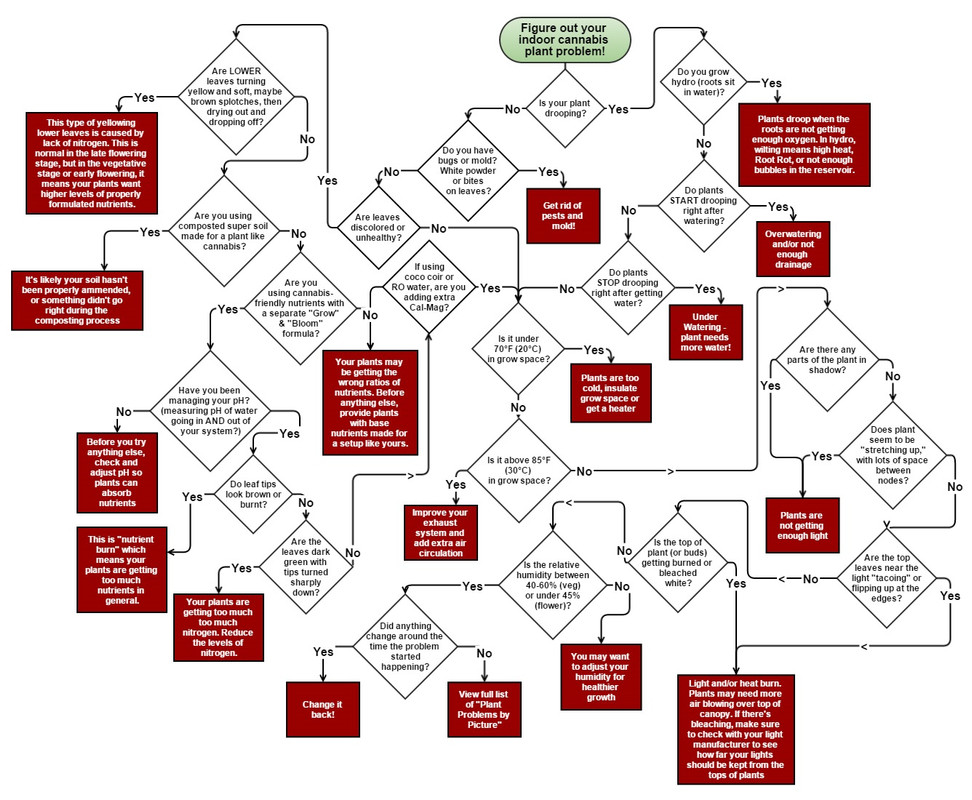
When it comes to growing cannabis, it's inevitable that you will eventually run into growing problems. I've never met a single grower who's never had ANY problems.
So don't beat yourself up when growing problems happen. They happen to every grower!
Just remember - how you REACT to problems determines whether you harvest ounces of potent buds... or end up totally killing your plants. I believe that the way growers react to problems is a strong reflection of their ability as a grower. I believe a grower who stays calm and figures out solutions to problems is capable of becoming a true growing master!
Growing cannabis can be easy, and when you have the right information, you'll know exactly how to react to problems as they arise.
Luckily, bringing your plant back to peak health is actually pretty simple - which explains why I can do it!
Arm yourself with the knowledge of these 7 simple things to check when your plants get sick, so you know how to give your plants a 100% recovery.
These tips were specially made to fix a whole host of possible issues with minimal work.
Catching and solving problems quickly means bigger, bulkier, more potent buds. Your cannabis will love you for it!
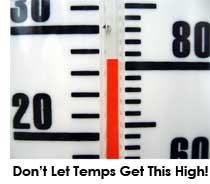
1.) Temperature & Humidity - They actually matter!
A good growing environment is crucial to the health of your plants. When the temperature (and to a lesser extent the humidity) is too high or too low for your plants, your plants will not grow properly no matter what else you do, and buds just won't fatten up. You may also end up with problems related to plant stress such as hermies.
Too much heat (or arid conditions) will generally sap the strength of your plant and force it to drink more water than normal for plant transpiration (the process of water movement through a plant and water evaporation through leaves, stems and flowers). A plant drinking more water than usual can have unexpected consequences. Sometimes hot, dry temps can cause unexpected nutrient burn (plant tips curl or turn brown from high levels of nutrients) because your plant is absorbing more nutrients than normal at the roots, alongside the extra water.
If there is a particular source of heat that is harming the plant (like a hot grow light), you'll know because the leaves closest to the source of the problem will wilt and turn a brownish colour. Heat or light-stressed leaves/buds can also get bleached and appear pale or white.
A generally too-hot environment can cause the stems of your plant to droop as if under- or over-watered, even when there's plenty of water at the roots.
Plants that suffer from extreme heat stress for too long may not recover and sometimes are unable to straighten their posture and continue growing.
Watch Your Humidity, too - Just remember that high humidity can help young plants grow faster, while Low humidity is crucial to prevent mould during the flowering/budding stage.
Humidity is a term used to describe the amount of water vapour present in the air at any given place, and the amount of water in the air is related to the local temperature.
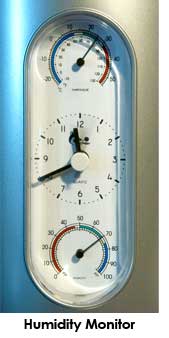
It is common for new growers to not pay attention to humidity at all, and this can sometimes cause otherwise unexpected and/or unexplainable problems.
Young cannabis plants seem to grow fastest when the relative humidity is in the 40-70% range.
It's especially common for young cannabis plants to show false signs of nutrient deficiencies when the relative humidity of the grow area drops below the optimal range, especially when things get really dry.
If plants are grown in constant dry conditions, they can adjust and some strains will be able to grow just fine, especially if they're provided with plenty of water at the roots.
Young plants, new clones, and vegetating plants that are used to more humid conditions tend to be hit the hardest by a dry spell.
In the flowering stage, when possible, humidity should be kept below 45% to prevent mold and increase resin production.
When humidity gets too high, the plant pulls excess water in through the leaves and increases your chances for mould.
Younger plants are relatively resilient, but high humidity is especially dangerous in the flowering stage because the insides of the buds can grow mould or bud rot and still look fine from the outside at first.
Additionally, there is some evidence that maintaining a low humidity environment in the flowering stage will help buds produce more terpenes (giving buds a stronger natural scent) and more trichomes (possibly even increasing the potency of your buds!).
What to Do: Get a temperature and humidity monitor. Control heat by whatever means necessary and keep humidity in check using the steps outlined below.
Indoors, most setups with grow lights will require that you vent out hot air using a fan and/or an exhaust system. If you're worried about the smell of cannabis, make sure any heated air being vented outside grow room/house gets filtered to remove the scent of cannabis. For example, many growers choose to get a carbon scrubber to "scrub" all odours before the hot air is blown outside. By creating good suction with an efficient exhaust system and adding a carbon scrubber, you can basically eliminate all smells from the grow room, inside and outside of the house.
When the humidity is too low (air is dry), it's important to make sure you provide plenty of fresh water to your plants at all times. You may need to reduce the amount of nutrients you're providing as the plants will drink more water and therefore absorb more nutrients through their roots than when the humidity is not as dry.
An oscillating fan will circulate air in the room as well as provide a gentle breeze for your plants, reducing hot spots from forming, and a small one will cost less than £20. More about air circulation in step 4 of this article...
When it comes to controlling humidity indoors, you may need to use a humidifier and/or a dehumidifier to keep the humidity in the optimal range. A humidifier adds moisture to the air while a dehumidifier takes moisture out.
Controlling your grow room humidity is one of the tricks that separates the expert growers from the beginners.
You can get some pretty fancy humidity gauges to place in your grow room, and products to help change the humidity are commonly found at department stores, hardware stores, or most stores that sell home appliances. There are also some DIY options discussed in our complete article about controlling indoor humidity.
Here's the most important things to keep in mind when it comes to the humidity of your cannabis grow room.
Ideally, your grow room will have a humidity of 60%-70% during the vegetative stage, and should be lowered to below 45% during the flowering stage.
As your buds fatten up, it is beneficial to continue to drop the humidity of the grow area, if you can, to increase resin production and cause your plant to product more terpenes (the stuff that makes your buds smell great), though lowering the humidity too low can increase the chance of your plant running into problems.
During the last 2-3 weeks before harvest, I use a dehumidifier to dramatically drop the humidity of my grow area as low as I can, which also prevents bud rot during the last few weeks.
As an added bonus, dropping the humidity this way during the last few weeks of your plant's life increases trichome production, so you harvest sparkly, crystal-covered extra-potent buds.
With the right tools, the task of maintaining humidity can be close to automated, and you will see huge benefits compared to the amount of time and money you invest.
When the air feels moist or humid (or a humidity monitor alerts you to high humidity), it's extra important to ensure that plants get plenty of air circulation and have lots of air movement. You also want to avoid letting leaves touch each other during periods of high humidity. You can fix constantly too-humid conditions with an exhaust system, fans, and possibly a dehumidifier.
When the air is too dry indoors, you can either choose to let your plants grow hardened to the arid air, or you can use something like a "swamp cooler" to add humidity while also reducing the temperature of your room.
Outdoors, you have less options to reduce heat during a heat wave than growing indoors. You have even fewer options when it comes to controlling humidity outdoors. However, you are able to monitor your local weather via forecasts, and you can use that knowledge to help you prepare for whatever conditions are coming.
It is possible to partially shield your plants when you know the temperature is going to get hot. You can also adjust your watering schedule to make sure plants at least have plenty of water.
Some things to try when you know the weather outside is going to be hot or dry:
water plants in the evening or early morning to help prevent water evaporation during the hottest hours
kelp extract for roots - provide a small amount of liquid fertilizer that contains seaweed kelp extract (can help protect against heat stress)
increase shade to reduce the heat experienced by plants - you can use an old sheet or other cloth as a short term solution, or get a professionally made "Sun Shade Sail" which is made particularly to create shade outdoors. It's important to remember that giving plants shade for more than a few days will make them less "hardened" to the sun, and you may need to reintroduce full sunlight back slowly to prevent them from getting shocked from the light intensity
move potted plants - luckily with potted plants, it's usually easier to move them out of direct sunlight during a heat wave
take extra good care of heat-stressed plants - when cannabis plants appear heat-stressed, try to baby them as best you can, and offer shade during the hottest days.
When growing cannabis outdoors, too humid conditions are harder to battle than purely high temps.
It can often take a few weeks for plant to recover after a hot or dry spell, so prevention is the best medicine for outdoor plants.
If you are growing cannabis plants outdoors, you should also be paying attention to humidity when watching your local weather forecast so you can prepare when humidity is going to be too high. During humid conditions, it's important to remove wind breaks that may be blocking wind from hitting your plants, which will increase airflow around the plants. By making sure plants are getting lots of fresh, moving air, you can combat mould and other problems normally associated with too-humid air.
Avoid over-watering plants during very humid conditions, and try to avoid allowing leaves to touch each other. Cannabis plants lose moisture through their leaves, and two leaves laying on top of each other during humid weather creates a humid environment for mould to take hold. Some light defoliation (removing leaves) may be needed to help prevent leafy outdoor plants from laying all over each other when it's too humid, possibly creating the right conditions for mould to grow on the leaves or buds.
Keeping outdoor cannabis plants in pots or other moveable containers can be very beneficial when growing outdoors if you live close enough to your grow spot, because it gives you better ability to move the plants if needed to react to weather conditions. When your plant is in the soil, there's very little you can do in bad weather besides wait and hope.
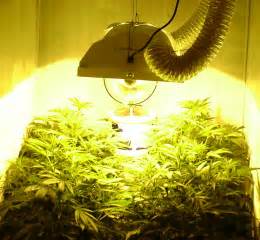
2.) Cannabis loves light! But not too much light....
When growing cannabis, the mantra when it comes to lights is usually "More is better!" To be honest...it's true! More light usually is better!
You see, light is like "food" for your marijuana plants. When plants are growing very slowly, but aren't showing signs of other problems, the cause is often that they aren't getting enough light.
The amount of light you give your plants is strongly correlated with fast your plants grow, as well as how much buds your plants will produce during the flowering stage.
Many new growers don't realize they're not giving their plants enough light. As a very general rule, you will need at least 100W worth of electricity going into your indoor grow light for the successful growth of one plant to harvest, even with efficient CFLs or LEDs, and more is almost always better.
More light = More yields + Faster Growth
(Yes, but there can also be too much light!)
If plants are growing very slowly, if they're not drinking much water, or otherwise aren't doing well without showing any other major signs of problems, often the problem is the plant simply needs more light to thrive.
General rule for yields: 0.5g/watt for new growers, 1g/watt for experienced growers.
As a very general and unscientific rule, a new grower who doesn't run into major problems can expect up to about 0.5g of yield per watt of light. An experienced grower can expect about 1g of yield per watt of light.
This rule is referring to how many watts of electricity are actually being pulled out of the wall, not some sort of "equivalent" amount of watts. If an LED pulls 90W of electricity from the wall, you should plug that into the equation, not the claim that it's "equivalent" to a 400W HPS light. Same for CFLs, if you have a CFL bulb that pulls 26W of electricity from the wall, you should count that as 26W, and ignore the fact that it says "equivalent to 100W" on the front.
Of course, this rule varies quite a bit depending on the type of light, the strain being grown, the size of the plants, etc. However, it's a good general guide if you're not sure how much light you need, and it can help you decide if you might not have enough light for your plants.
To put that into perspective...
400W of light will net the average grower about 200g or yield, or 7 ounces of dried bud
400W of light will net the experienced grower about 400g, or 14 ounces of dried bud
Keep in mind that there are many other factors that go into this, and this is not a guarantee as much as a general rule. Moreover, smaller lights tend to get better yields per watt than fewer larger lights. Lights that are kept closer to plants (without signs of light stress) will also tend to produce bigger yields and faster growth. Most importantly, the strain you start with and the training methods you use to get your plants to more efficiently use your indoor grow lights will have a huge impact on your growth rates and final yields.
But can there be too much light?
Yes, there can be too much light!
Unfortunately, more light is not always better. Cannabis plants can be fickle. You want to give them very bright light... but not too much light.
When marijuana plants are young, they are weak and cannot tolerate much light at all. Yet as they get older, and especially in the flowering stage, marijuana plants want almost all the light they can get.
The problem of too much light often occurs indoors, when your grow lights are too close to the plants. This essentially gives them their own version of sunburn.
Young plants, seedlings and new clones are especially prone to suffering from too much light.
When growing outside... It's uncommon for mature marijuana plants to get too much light when they're growing out. How can you tell if there's too much light?
The main way you know your plants are suffering from light burn is if only the leaves closest to the lights are affected.
What to Do: Most importantly, pay attention to your plant and watch out for signs of light stress, which will only affect the parts of the plant closest to your grow lights.
For HPS, Metal Halide and CFL grow lights, use the 'back of your hand' test.
Back of Your Hand Test - For MH, HPS, CFLs and T5 grow lights (not always effective for LEDs or very high-power HPS lights with strong air conditioning)
Set up your grow lights and turn them on (make sure they've had time to warm up)
Gently place your hand - palm down - right above the tallest part of your plant
Wait 10-15 seconds
If the heat coming from the light feels too warm for your hand, then it's going to be too much light for your cannabis.
LEDs generate very little heat, but can still light-stress plants, so it's best to keep high powered LEDs (above 90 watts) at least 10 inches away from your plants. When the individual bulbs are bigger than 1W (for example if it has 3W or 5W bulbs), you'll want to keep the lights even further away, up to 2-3 feet for some of the newer, extremely powerful LED grow lights. When it comes to LED lights, I highly recommend listening to the specifications from the manufacturer when it comes to how far away to keep the lights from your plants.
It's hard to make exact rules about how far LED grow lights should be from your plants, as each model is so different, so start with trusted lights that are proven for growing marijuana, and just be aware of the possibility of light stress. Start LED grow lights further from your plants than you think you should, and slowly move lights closer each day until you've found the "sweet spot."
To determine if your plant is getting light stressed from LED grow lights (or very high-powered HPS grow lights), you use the appearance of your plant's leaves to determine if the lights can be moved closer.
If leaves closest to the lights start showing signs of stress (leaves turning brown/crispy or buds being bleached white), move the lights further away.
Use extreme caution when attempting to move your grow lights closer, and avoid moving them more than an inch closer in a day, so you can watch the plant's reaction.side, though young seedlings can still get light stress if they're transplanted into direct sunlight, or plants can get stressed if moved from relative shade into bright light too suddenly.
The intensity of a grow light that is too close will dry up a plant, and turn the edges of its leaves brown and crispy, almost like nutrient burn.
High Pressure Sodium (HPS) lights have the meanest reputation for 'light-stressing' plants, but many of the newer, more powerful LEDs(Light Emitting Diodes) do it, too!
3.) Nutrient Problems & Root pH
Cannabis nutrient problems are often closely related to the pH at the roots of your plants. That's because when the root pH is off, it can cause your plant to show signs of a nutrient deficiency, even if the nutrients are actually there in the soil.
Growers need to monitor their root pH in almost all growing setups for the best results. The only method of growing that consistently gets good results without monitoring pH is growing cannabis in composted super soil. The reason you don't need to monitor pH in that type of setup is you are actually creating a workforce of beneficial microbes in the soil that act as the "middleman" to monitor the pH for you. They will automatically adjust the pH so that your plants can absorb nutrients unless your water is extremely acidic or alkaline. Unfortunately, without growing in composted super soil, it is important for cannabis growers to regularly monitor root pH to prevent nutrient problems.
Some growers get lucky and the pH of their water and soil happen to be just right without any additional adjustment or monitoring. Yet most growers will still achieve better growing results by monitoring pH, and knowing your pH will give you additional information to help understand when things are going wrong with the plant for seemingly no reason.
For those who aren't lucky enough to magically have the right pH for cannabis plants, or for growers looking for a simple way to ensure that all grows go smoothly, there's easy steps you can take to make sure your plants get exactly what they need.
Nutrient and root pH problems are easy to solve with the right information!
What to Do: The goal is to give your plant exactly the kind of nutrients it needs to thrive, and provide the correct pH at the roots so your plants can properly absorb nutrients.
Note: Cannabis plants cannot absorb nutrients properly if the pH at their roots is too high or too low. So even if the nutrients are present, you'll still get what look like nutrient deficiencies if you don't maintain the right pH.
First, if you are providing your plants with nutrients, check your nutrients to make sure they have all the necessary elements and minerals for proper growth.
An easy and simple nutrient systems that for beginning cannabis growers in soil is Botanicare Pure Blend for soil.
A time-tested, simple nutrient system for growing cannabis hydroponically (including in soilless mediums like coco coir) is the General Hydroponics Flora Trio.
If you want to cut through the technical marketing talk and get straight to what works, it's important you learn a little bit about what kind of nutrients are needed by the cannabis plant during different stages of growth.
These days, there's lots of nutrient systems available that are specifically formulated for plants like cannabis, and they help take all the guesswork out and give your plants exactly the nutrients they need. It doesn't have to be expensive to provide everything you cannabis plant needs!
Now here's what you need to do, depending on whether your growing in a soilless medium (like coco coir), or if you're growing hydroponically with your plant roots directly in water...
Potted plants... when you believe there may be a problem with the nutrients or pH with your plants that live in a container, it is often a good idea to "flush" plants with 2-3x the size of your container's worth of pH'ed nutrient water (usually at half strength). For the best results with flushing, water should be able to drain freely from the bottom of your container. If water is not draining freely, or if it takes plants a long time to dry between each watering, you may actually have a problem with drainage. This will replace missing nutrients in addition to getting rid of excess salts that build up over time which can mess with your pH or otherwise prevent nutrient absorption.
Hydroponic plants with roots in water... when you believe there may be a problem with the nutrients or pH, it is often a good idea to completely change your water reservoir and replace it with fresh pH'ed nutrient water. When growing cannabis plants hydroponically, a huge tool to help you understand what's going on at the roots is the "PPM" of your water. This is a measure of how much "stuff" is in the water, and can give you information about what's happening with your nutrients and pH if you're experiencing problems. Because you've just flushed your plant, provided the exact nutrients she needs, and adjust the pH to the proper level, you will clear up any possible causes of nutrient deficiencies.
Once you're positive you're providing the nutrients your cannabis needs, and you've adjusted the water pH to the proper levels, you should notice any nutrients problems clearing up quickly. Remember, if leaves get damaged from a nutrient problem, it is unlikely that particular leaf will ever recover and turn green. What you're looking for is that the problem stops spreading, and that any new growth appears green and healthy.
4.) Breeze & Air Circulation
It’s important for air to be moving around your plants to both prevent heat spots and make sure your plants are getting plenty of fresh CO2 to achieve the best growth.
Having air moving constantly around your plants will also help stop pests from attacking your grow room, and will even help prevent mould (especially the dreaded white powdery mildew).
When it comes to fans, don’t point fans directly at plants - usually it’s better to be point fans at a wall to disperse the air, or have fans blowing over and under the plant canopy.
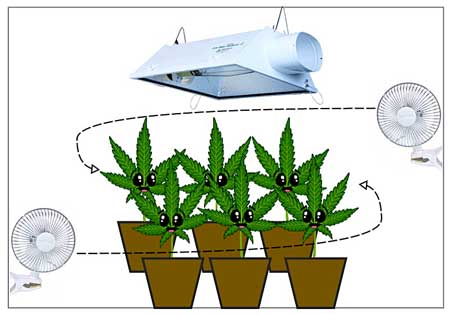
Best case scenario is you want to set up your fan system so that all the leaves on the plant are gently rustling, yet no stems or branches are waving around from the force of the wind.
One of the reasons you need great air circulation is your plants “breathe” CO2 during the light hours, almost like we breathe oxygen.
Unless your plants are in a big open space with lots of air, or you are supplying your plants with CO2, you need to have some sort of exhaust system to pull away hot, stale air and bring in new fresh air for your plants.
An exhaust system doesn't have to be anything fancy. At its simplest, an exhaust system can be two holes and a fan (with the fan place in one of the holes pointed out from your grow area). Having a fan constantly pulling hot air out and bringing fresh air in from your intake hole will help ensure that your plants have the fresh air they need.

Because your plants need CO2 when the lights are on in order to function properly, a completely sealed off grow box is not good unless you’re artificially adding CO2 - your plants will suffer if they don’t get enough CO2 in a sealed grow box even if the temps are completely under control.
Many growers like to supplement their plant with extra CO2 in an attempt to increase yields or growth rate, but it's important to note that the amount of CO2 found in regular air is plenty for your plants unless you have extremely powerful grow lights (1000W HPS, high power LEDs, etc).
This is important! Adding more CO2 to the air before your plants have maxed out on the amount of light they use will not help plants grow any faster, and high levels of CO2 are dangerous to humans so you could be doing more harm than good by adding CO2 if you don't have the right setup.
For most growers, a proper exhaust system and a few strategically placed fans is all you need when it comes to air circulation.
5.) Watering & Healthy Roots

In a metaphorical sense, the roots are the heart of your cannabis plants.
When roots become sick, the health of the entire plant quickly falls apart.
Yet sometimes, cannabis plants with sick roots show no signs that there are any problems until things become grim.
Luckily, it's easy to check for issues and even easier to solve them with one of a few options.
To check for root problems, smell the root area of your plants. Go on, no one's looking!
If you can, smell the bottom of the pot where the excess water comes out. The water that runs out the bottom should generally have a neutral smell; a 'stinky' smell is an indicator that your plant may be suffering from 'root rot' or other problems
Some tips for healthy roots
Water potted plants properly! Make sure water can drain freely from potted plants, and don’t water too often. Learn how to water potted cannabis plants so you never run into problems.
Make sure that roots get access to plenty of oxygen. With potted plants this is accomplished by making sure the growing medium is relatively loose and has plenty of extra space for air (many growers add more air pockets by adding extra perlite). In a hydroponic setup where the roots are growing directly in water, generally the more bubbles the better, as this dissolves lots of oxygen directly in the water. Water that is a lower temperature can also hold more oxygen than water at a higher temperature, which is why controlling temps is so extra important in hydroponics setups!
Certain supplements help keep roots healthy (more info below)
If you’re using a non-standard growing mediums (anything besides soil, coco coir, etc), know how to take care of your plants in their growing medium! For example it can be difficult to grow cannabis in something like straight perlite unless you maintain a water reservoir because perlite can not hold any water - straight rockwool is bad for the opposite reason, it holds onto a lot of water and not enough air. Your plant roots cannot ever be allowed to dry out, and they should also never be sitting in stagnant water. Roots need a mixture of moist conditions and plenty of oxygen to make sure plant grows as fast as possible.
What to do:
If you think you may have root problems, here's what to do:
1.) Address the problem that is causing the root problems.
2.) (Optional) Start adding a root supplement to your nutrient-water when you feed.
Hydroguard is my favourite root supplement, it's cheap and will build up colonies of good bacteria that out-compete the bad bacteria and actually promote plant growth.
In addition, the beneficial bacteria will offer protection for those times when the temperature of the grow area rises at a time when you can't control it. When I first got started with bubbleponics, I had a few tough bouts with root rot, and Hydroguard has saved my plants many times.
Over the last few years, I've tried many "good bacteria" products including the ($$$) Great White and Subculture B additives, but no product has ever worked as good for at maintaining healthy roots as super cheap, readily available Hydroguard .
Another common root supplement is kelp extract for roots, usually provided as a small amount of liquid fertilizer that contains seaweed kelp extract. These types of supplements can help protect against heat stress, but may not be suitable for many hydroponic setups as the organic material can clog up tubing.
6.) Bugs / Mould
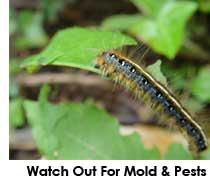
I believe that growing marijuana hydroponically is often simpler for beginners, because this automatically eliminates many of the bug problems growers run into when growing in soil.
So many growers struggle with bugs, and just by growing cannabis with a soil-less medium like coco coir, you dramatically reduce the chances of bug infestations.
However, even when growing hydroponically, the right conditions can make your cannabis plants themselves, not the soil, a breeding ground for bugs such as whiteflies, caterpillars, spider mites, and gnats. When growing in soil, bugs are a common pest to marijuana gardens.
Mould can be just as annoying as bugs, and can be contagious between plants in the same room, and even the same house!
As with bugs, your soil-less growing medium is relatively safe from mould when growing with hydroponics, so only the plant and its environment need the treatment.
What to Do: If you notice any signs of bugs or mould, don't wait. Act quickly!
One of the worst types of pests for cannabis growers are spider mites. They actually have earned the nickname "the borg" because of their ability to seemingly come back from the dead and take over an entire grow room or destroy a whole crop.
When you believe you have bugs, the first step is to identify what type of bugs or pests you actually have.
For many bugs, pests, and moulds, SM-90 is miracle cure with a uniquely delicious citrus scent. It's perfectly safe for humans and animals, so you can use it even when you're just a few weeks away from harvest.
Mix 1 part SM-90 to 5 parts water, and mist the leaves of your plant (I use a mister ) when the lights are off.
This will stop mould and shield the treated parts from further mould infestation. SM-90 also deters many types of bugs including caterpillars, gnats, spider mites, aphids, and other creepy crawlies.
SM-90 kills most bugs/mould instantly on contact, and will protect your plant from being attacked again.
Gently wipe off the mould and dead bugs after your first treatment, then mist the plant once more for an armour-plated plant.
Also consider adding an oscillating fan to your grow room to get air moving over the leaves.
As mentioned in step 4, good air circulation and a slight breeze is not only good for the plant by itself, but will also disturb bugs AND prevent excess moisture on the leaves which acts as a major deterrent for mould.
7.) Still Not Sure? Here Are Your Next Steps...
Going through the previous steps will solve quite a few different problems you could be running into, but what if none of the ones mentioned so far seems to apply to your problem?
If you've gone through all the above steps, and you're still having an unexplained growing problem, the link below will take you to our deficiencies, bugs and viruses page where we go into detail on the many individual problems that can be effecting your cannabis plant.




